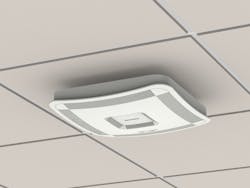CommScope adds open interfaces, virtualization for 5G enterprise small cells
CommScope today introduced open interfaces, virtualized RAN functions, and new radio points for its OneCell small cell platform, to provide an innovative and open approach for operators to deploy 5G networks in enterprises and venues.
The enhanced OneCell solution leverages the latest open RAN and management frameworks to deliver in-building wireless services – a traditionally under-served use case but one that will be critical for operators to address enterprise needs. New innovations for the platform, according to CommScope, include the following:
5G mmWave and sub-6 GHz bands support: The addition of these bands to the OneCell RP5000 Series of radio points enables operators to address 5G in-building needs. This includes 28 GHz and 39 GHz mmWave bands, CBRS and C-band in the US, and 3.5 GHz bands in Europe and the rest of the world.
Virtualized 5G NR baseband functions: This allows baseband functions to run on x86-based server platforms anywhere in the network to support 5G network slicing – virtual end-to-end networks customized for each application requirement. For example, capacity-related functions can be centralized for efficient pooling, while data and media delivery can be pushed to the edge for low latency.
O-RAN 7.2x fronthaul interface: This allows fronthaul over Ethernet. CommScope implements further innovations such as single cell operation across multiple radio points to maximize user QoE, and cell virtualization to increase spectral efficiency. These are critical to meeting the requirements of enhanced mobile broadband and ultra-reliable low latency communication 5G use cases.
Open Network Automation Platform (ONAP) framework support: This enables native management of OneCell under the O-RAN Alliance’s O1 Operations and Maintenance (OAM) interface specification. ONAP simplifies on-boarding, provisioning, orchestration and management for operators by providing a common framework across all network elements and services.
“CommScope fully supports open interfaces to stimulate innovation,” said Upendra Pingle, vice president of Distributed Coverage and Capacity Solutions for CommScope’s Venues and Campus Networks segment. “We are delivering solutions for in-building cellular coverage that enable operators to realize the potential of their 5G networks for all types of subscribers and use cases.”
Learn more CommScope and its recently acquired ARRIS and Ruckus Networks subsidiaries at www.commscope.com.
